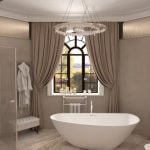Are you wondering how to decorate a 1950s home? The 1950s was a time of significant cultural and design shifts, and the decor of that era reflected the optimism and prosperity of post-war America. Understanding the unique style of the 1950s is crucial for anyone looking to recreate this iconic look in their own home. From color palettes to furniture styles, there are specific elements that define 1950s home decor, and we’re here to guide you through it.
The 1950s were known for their bold and vibrant color palettes, with pastel hues and bright shades dominating interior design. This era saw a departure from the muted colors of previous decades, and instead embraced lively tones like aqua, pink, and yellow. Additionally, popular combinations such as turquoise and red or black and white checkerboard patterns were commonly used in 1950s homes. Understanding the significance of these colors will be essential in authentically decorating a 1950s home.
When it comes to furniture and layout, the 1950s favored clean lines, tapered legs on chairs and tables, and sleek designs. Furniture pieces often featured geometric shapes and futuristic elements that represented the growing influence of technology on design.
Arranging furniture in a way that promotes an open flow throughout the space was also characteristic of 1950s homes. As we delve into each aspect of 1950s home decor, we will provide expert tips on selecting authentic pieces while creating a layout that captures the essence of this era’s style.
Color Palette of the 1950s
The 1950s were characterized by a vibrant and colorful aesthetic, and this was reflected in the color palette used in home decor during that time. Here are some of the popular colors and combinations that defined the era:
- Pastels: Soft shades of pink, blue, yellow, and mint green were incredibly popular in 1950s home decor. These colors added a delicate and feminine touch to interiors.
- Bold primaries: Bright red, yellow, and blue were also widely used in 1950s homes. These bold colors added a cheerful and optimistic vibe to interior spaces.
- Contrasting combinations: The 1950s embraced contrast in color pairings. Black and white, as well as pink and black, were common combinations that added a sense of drama to home decor.
When decorating a home with a 1950s theme, it’s important to consider the use of these colors and combinations throughout the various rooms of the house to achieve an authentic look. Whether you’re painting walls, selecting upholstery fabrics, or choosing decorative accessories, incorporating these iconic colors will help transport your space back to the fabulous fifties.
In addition to using these colors on walls and furnishings, it’s also important to pay attention to details such as kitchen appliances, linoleum flooring patterns, or bathroom tile choices as they can also contribute significantly to achieving an authentic 1950s color scheme throughout your home.
Furniture and Layout
The 1950s was a time of significant change in interior design and home decor. The style of the era was characterized by a focus on functionality, simplicity, and a futuristic aesthetic. When it comes to achieving an authentic 1950s look in your home, selecting the right furniture and arranging it properly is key to capturing the essence of this unique period.
Mid-Century Modern Furniture
One of the most iconic features of 1950s home decor is the use of mid-century modern furniture. This style emphasized sleek lines, organic shapes, and minimalist forms. Look for pieces with tapered legs, geometric patterns, and clean, simple silhouettes. Key items such as Eames chairs, Danish teak furniture, and modular shelving units can all contribute to creating an authentic 1950s aesthetic.
Layout and Arrangement
When arranging your furniture to achieve a 1950s look, consider open floor plans and minimal clutter. In the 1950s, there was an emphasis on creating functional yet stylish living spaces. Arrange your seating areas to encourage conversation and socializing, with a focus on clean lines and symmetry.
Replicating Vintage Styles
To truly capture the spirit of the 1950s in your home decor, consider replicating vintage styles through careful selection and placement of furniture. Look for items that feature pops of color or retro patterns that were popular during this era. Additionally, incorporating statement pieces such as kidney-shaped coffee tables or boomerang-shaped side tables can instantly evoke a sense of nostalgia for the mid-century period.
By understanding the key elements of 1950s furniture and paying attention to layout and arrangement details, you can bring an authentic retro vibe into your home with ease. Whether you’re starting from scratch or integrating vintage pieces into your existing decor, selecting the right furniture and arranging it thoughtfully will help you achieve a true 1950s aesthetic in your living space.
Accessories and Decor
The 1950s were a time of prosperity and optimism, and this was reflected in the home decor of the era. Homes were adorned with various decorative items that added to the overall aesthetic of the space. From unique lamps to stylish wall art, incorporating these elements into your home can help you achieve an authentic 1950s look.
Mid-Century Modern Lamps
One of the most iconic decorative items from the 1950s is the mid-century modern lamp. These lamps often featured sleek, geometric designs and were made from materials such as brass, teak, and fiberglass. When decorating a 1950s-inspired space, look for table lamps with bold, angular shapes and floor lamps with tripod bases. These pieces will add a touch of retro charm to any room.
Vintage Clocks
Another popular decorative item from the 1950s is the vintage clock. From sunburst designs to starburst motifs, clocks from this era often featured futuristic and whimsical elements. Incorporating a vintage clock into your decor can serve as both a functional piece and a conversation starter. Look for wall clocks with distinctive designs and vibrant colors to infuse your space with authentic 1950s style.
Retro Wall Art
When it comes to wall art, 1950s decor often featured pieces that embraced bold colors and abstract shapes. Consider incorporating paintings or prints that showcase the vibrant and dynamic artistic style of the era. Additionally, metal wall sculptures were also popular during this time period, adding texture and visual interest to walls.
By carefully selecting and showcasing these key decorative items such as lamps, clocks, and wall art in your home, you can capture the essence of 1950s decor while adding personality and flair to your living space.
Flooring and Wall Treatments
The 1950s era was characterized by a unique approach to flooring and wall treatments in home decor. One of the most popular flooring choices during this time was linoleum, which came in a wide variety of colors and patterns.
For those looking to replicate the 1950s aesthetic in their homes, opting for retro linoleum or vinyl flooring can instantly transport you back to this iconic era. Additionally, wall-to-wall carpeting became increasingly popular during the 1950s, particularly in bedrooms and living areas, so consider incorporating this style of flooring for an authentic look.
In terms of wall treatments, wallpaper was a staple in 1950s homes. The designs ranged from bold, graphic prints to more subdued patterns, but all typically featured vibrant colors that added a lively touch to any room.
To recreate the look of the 1950s, consider using wallpaper with geometric shapes, atomic-inspired designs, or classic floral motifs. If wallpaper isn’t your preference, another option is to use paint colors that were popular during the 1950s such as pastels or bold hues like turquoise and coral to create an authentic vintage vibe.
When striving for an accurate representation of a 1950s home, it’s important to pay attention to details like flooring and wall treatments. These elements can truly set the tone for your decor and transport you back to a time when bold patterns and vibrant colors were all the rage.
Whether you opt for retro linoleum flooring or embrace the whimsical charm of vintage wallpaper, capturing the essence of the 1950s through these key design features will undoubtedly bring a sense of nostalgia and character to your living space.
Kitchen and Dining Room Decor
The 1950s were a time of post-war optimism and prosperity, which is reflected in the cheerful and vibrant color palettes used in home decor. When it comes to creating a retro-inspired kitchen and dining space reminiscent of the 1950s, there are several key elements to consider. Here are some tips and ideas to help you achieve an authentic 1950s look in your kitchen and dining room:
- Color scheme: The color palette of the 1950s was characterized by bold and bright hues such as sunny yellow, mint green, turquoise, and pastel pink. Consider incorporating these colors into your kitchen and dining room through wall paint, cabinetry, countertops, or even small appliances.
- Retro furniture: Look for vintage-inspired dining tables and chairs with sleek lines and tapered legs. Chrome dinette sets were especially popular during this era and can instantly evoke a 1950s vibe in your dining space.
- Kitschy accessories: Add playful touches to your kitchen and dining room with retro accessories like milk glass dishes, vintage linens with whimsical patterns, classic Coca-Cola memorabilia, or atomic-inspired salt and pepper shakers.
By combining these elements with the right flooring, wall treatments, and lighting fixtures, you can create a kitchen and dining room that captures the spirit of the 1950s. Whether you want to go all-out with a full-on retro theme or simply add subtle nods to the era, there are plenty of ways to infuse your home with vintage charm from the 1950s.
Bedroom and Bathroom Decor
The 1950s were a time of significant change and innovation, and this was reflected in the design and decor of homes during that era. When it comes to adding 1950s flair to bedrooms and bathrooms, there are several key elements to consider. One of the most essential aspects of 1950s bedroom decor is the use of pastel colors, such as pale pink, mint green, and baby blue.
These soft hues create a calming and inviting atmosphere that was popular during this time period. For a truly authentic 1950s look, opt for furniture with clean lines and tapered legs, which were common features of mid-century modern design.
In addition to color schemes and furniture choices, incorporating vintage accessories can further enhance the 1950s aesthetic in both bedrooms and bathrooms. Look for items such as ceramic figurines, decorative mirrors with scalloped edges, and geometric-patterned linens to bring a touch of retro charm to these spaces. When it comes to bathroom decor, consider adding pops of color through towels, shower curtains, or even original vintage wall tiles if available.
When it comes to replicating 1950s design in your home, attention to detail is essential. This means paying close attention not only to the major decorative elements but also to more subtle touches like lighting fixtures, hardware, and storage solutions. By carefully selecting each component with an eye toward achieving an authentic 1950s look, you can create a space that feels as though it has been transported directly from the mid-20th century into your home today.
| Element | Tip |
|---|---|
| Color Schemes | Use pastel colors such as pale pink and baby blue for an authentic 1950s feel. |
| Furniture | Opt for clean-lined pieces with tapered legs for a mid-century modern look. |
| Accessories | Incorporate vintage items like ceramic figurines or decorative mirrors for a retro charm. |
Bringing It All Together
The 1950s was a time of prosperity, innovation, and style in American home decor. To bring the essence of this era into your own home, it is important to understand the key elements that define 1950s decor: color palette, furniture, accessories, flooring and wall treatments, as well as specific decor for the kitchen, dining room, bedroom, and bathroom.
One of the distinctive features of 1950s home decor is the use of bright and vibrant colors. Popular hues during this time period included pastel shades such as pink, mint green, turquoise, and yellow. Combining these colors in various ways adds an authentic 1950s feel to any space. Additionally, bold patterns and prints were often used for upholstery and curtains to further enhance the lively atmosphere of a 1950s home.
Another essential aspect of achieving a 1950s look is selecting furniture and arranging it in a way that reflects the style of the era. Mid-century modern furniture with clean lines, tapered legs, and gentle curves was prevalent in homes during this time.
When arranging furniture, it’s important to create conversation areas by grouping seating together to encourage interaction-an integral part of social life in the 1950s. Incorporating pieces like boomerang-shaped coffee tables or kidney bean-shaped sofas can also add an authentic touch to your space.
To complete the overall aesthetic of a 1950s home, attention to detail is crucial when selecting accessories and decor items. Lamps with atomic or futuristic designs were popular choices for lighting during this era.
Meanwhile, decorative wall art featuring geometric shapes or abstract designs can serve as focal points in rooms while adding visual interest. By incorporating these key elements into your home decor using a step-by-step approach outlined above you can achieve an authentic 1950s look that will transport you back to this iconic era every time you enter your space.
Conclusion and Additional Resources
In conclusion, decorating a 1950s home can be a fun and nostalgic way to add character and charm to your living space. By incorporating the popular color palette of the era, selecting furniture and decor that reflects the style of the time, and paying attention to details such as flooring and wall treatments, you can achieve an authentic 1950s look in your home.
Whether you want to fully embrace the retro vibe or simply incorporate a few vintage touches, there are plenty of resources available to help guide you through the process.
For those looking for further inspiration and guidance on 1950s home decor, there are a variety of resources available. From online forums and social media groups dedicated to mid-century modern design to books and magazines focused on retro interior styling, there is no shortage of information to help you bring the iconic look of the 1950s into your home. Additionally, attending vintage fairs or visiting antique stores can provide unique pieces that truly capture the spirit of the era.
Ultimately, embracing 1950s home decor is about celebrating the optimism and innovation that defined this iconic decade. By understanding the key elements of this style and paying attention to detail, you can create a space that pays homage to this nostalgic era while still feeling fresh and relevant in today’s modern world.
Whether you choose to go all out with a full retro makeover or simply add a few vintage pieces here and there, incorporating 1950s home decor into your living space can bring timeless charm and character to your home.
Frequently Asked Questions
How to Decorate Your Home Like the 1950s?
To decorate your home like the 1950s, you can start by choosing a color scheme that was popular during that time, such as pastel colors or bold, saturated hues. Consider adding retro furniture pieces like kidney-shaped coffee tables, mid-century modern sofas, and vinyl barstools.
Don’t forget to incorporate geometric patterns and abstract designs in your textiles and decor. Adding vintage appliances, atomic-inspired lighting fixtures, and kitschy accessories can also help capture the essence of 1950s decor.
How Did People Decorate Their Homes in the 1950s?
People decorated their homes in the 1950s with a focus on modernity and functionality. This era saw the rise of mid-century modern furniture characterized by clean lines, sleek curves, and minimal ornamentation. Pastel colors like pink, mint green, turquoise, and yellow were popular choices for paint and upholstery.
Atomic-inspired prints and quirky patterns were commonly used for curtains, wallpaper, and linens. In terms of accessories, decorative items featuring space-age designs and futuristic motifs were highly coveted during this time.
What Was the Style of Décor in the 1950s?
The style of decor in the 1950s was heavily influenced by the post-war optimism and technological advancements of the era. Known as mid-century modern design, this style emphasized simplicity, form, and function. Furniture designs were often sleek and streamlined with organic shapes inspired by nature.
The use of materials like wood, metal, plastic, and glass became more prevalent in home furnishings. Overall, 1950s decor was characterized by a combination of futuristic elements with a touch of whimsy and playfulness.

I’m thrilled to be your companion on this exciting journey through the world of home decor and design. With a passion for turning houses into homes and a keen eye for the finer details, I’m here to help you transform your living spaces into beautiful, functional, and meaningful havens.





